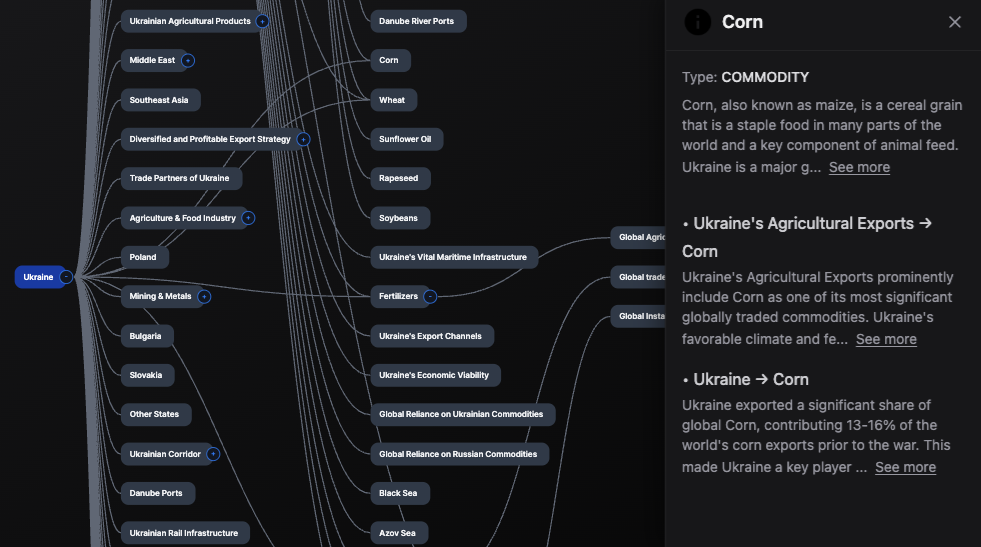CO₂: Achilles' Heel and Strategic Lever of the French Food Industry


Relationship graph generated by Datafalk Engine on stakeholders mentioned in the article
Introduction
This chapter analyzes the strategic role of CO2 in the French food industry, its supply risks, and possible resilience levers. Three key messages emerge:
- the critical dependence of the agri-food sector on CO2 for various uses,
- the structural vulnerability of the supply chain,
- the need for an integrated strategy combining diversification, innovation, and public policy.
1. Context & Issues
CO2 occupies a central place in many food processes, going far beyond beverage carbonation. Its function as a natural refrigerant, its role in preservation via modified atmosphere packaging, and its use in animal stunning make this gas an essential input to ensure the safety, quality, and durability of products. These uses also cover strategic niches such as greenhouse cultivation or decaffeination, which, although quantitatively less significant, contribute to national food sovereignty1.
In France, supply relies almost exclusively on CO2 by-products from heavy industries such as ammonia, bioethanol, or refining2. This structure creates an indirect dependence on the global energy situation, especially on natural gas, whose price and availability are strongly influenced by geopolitical factors3. Recent market volatility, exacerbated by crises such as the Russia-Ukraine conflict, has revealed that CO2 production can be reduced or stopped despite stable food demand.
This context is all the more complex as France has committed to reducing its greenhouse gas emissions by 40% by 2030 and achieving carbon neutrality by 20504. These objectives directly influence industrial production methods, with growing tension between climate imperatives and supply continuity. The food industry thus finds itself at the crossroads of environmental, economic, and ethical requirements, and must anticipate potential disruptions in a context of accelerated energy transition.
2. Detailed Analysis
The crises of 2018 and 2021 demonstrated the sensitivity of CO2 supply to energy fluctuations, notably through the temporary shutdown of fertilizer plants3. These precedents confirm that secure access to CO2 is not a hypothetical scenario, but a concrete and recurring risk. Shortages impact sectors differently: beverage carbonation faces immediate tension on available volumes, the meat sector faces operational and ethical dilemmas, and fresh products see their shelf life reduced, increasing food waste56.
The French industrial CO2 market is concentrated among a few major players such as Air Liquide, Linde, and Messer27. This concentration, combined with dependence on non-food industrial processes, increases the risk of systemic failure. Furthermore, logistics add another layer of fragility: maritime disruptions, rising transport costs, and vulnerability of global supply chains can indirectly affect national availability8.
Economically, the global food-grade CO2 market, estimated at $1.5 billion USD in 2024, could reach $2.8 billion USD by 20339. Such growth reflects a structural increase in demand, which intensifies competition for access to this resource. Shortages result in significant additional costs, potentially leading to higher consumer prices and reducing the international competitiveness of French producers.
To these economic challenges are added societal issues: dependence on CO2 stunning in the pork sector is strongly criticized for its impact on animal welfare10. At the same time, the loss of efficiency in preservation systems due to a lack of CO2 fuels food waste, already estimated at 8.8 Mt per year in France11. These ethical and environmental dimensions reinforce the urgency of a proactive approach, integrating both securing and transforming uses.
3. Synthesis & Recommendations
Ensuring the resilience of CO2 supply requires a set of coordinated actions between industry, public authorities, and user sectors. In the short term, internal optimization of CO2 use, through leak reduction and improved process yields, can be a quick and low-cost lever12. This optimization should be complemented by source diversification, including occasional imports and the development of biogenic CO2 from methanization, whose national potential is estimated between 600 and 900 ktCO₂/year13.
In the medium term, investment in industrial energy efficiency would reduce indirect exposure to natural gas fluctuations, the main trigger of past crises14. The deployment of strategic storage capacities for food-grade CO2, combined with priority rationing mechanisms in case of shortage, would strengthen operational continuity for critical uses.
In the long term, the rise of carbon capture, utilization, and storage (CCUS) technologies could decouple CO2 supply from ammonia or bioethanol production15. This approach, combined with R&D efforts on alternatives to CO2 for certain sensitive applications such as stunning, would reduce overall dependence while improving environmental and ethical standards. Public policies, through the SNBC, the France 2030 plan, and the CBAM, must play a driving role by guiding investments, reducing approval times, and explicitly integrating CO2 into national food and industrial sovereignty strategies41617.
Conclusion
CO2 is both a discreet input and a strategic pillar of the French food industry. Its supply chain, fragile by nature, remains exposed to energy and geopolitical shocks. Recent experience shows that inaction leads to economic losses, social tensions, and a deterioration of food security. The combination of internal optimizations, source diversification, technological innovations, and targeted public policies is the only way to secure supply while respecting climate objectives. This proactive, integrated, and multi-stakeholder approach will transform a vulnerability into a lever for transition towards a more resilient, competitive, and sustainable food industry.
Footnotes
-
https://www.atlascopco.com/fr-fr/compressors/wiki/compressed-air-articles/carbon-dioxide-uses ↩
-
https://lelementarium.fr/wp-content/uploads/2018/08/Dioxyde-de-carbone-2019.pdf ↩ ↩2
-
https://www.agridees.com/articles/lunion-europeenne-en-manque-de-co2/ ↩ ↩2
-
https://www.ecologie.gouv.fr/politiques-publiques/strategie-nationale-bas-carbone-snbc ↩ ↩2
-
https://www.adria.tm.fr/qualite-secu-aliments/lemballage-sous-atmosphere-modifiee-pour-limiter-le-gaspillage-alimentaire/ ↩
-
https://www.3trois3.com/derniere_heure/la-penurie-de-co2-au-royaume-uni-affecterait-la-filiere-de-la-viande_15342/ ↩
-
https://unctad.org/fr/news/la-vulnerabilite-des-chaines-dapprovisionnement-est-mise-en-evidence-alors-que-les-points ↩
-
https://www.businessresearchinsights.com/fr/market-reports/food-and-beverage-grade-carbon-dioxide-market-121737 ↩
-
https://www.ciwf.fr/actualites-et-publications/actualites/declaration-contre-letourdissement-des-cochons-par-dioxyde-de-carbone/ ↩
-
https://fr.airliquide.com/solutions/conservation-sous-atmosphere-modifiee-map/quest-ce-que-lemballage-sous-atmosphere-modifiee ↩
-
https://innovation.grdf.fr/challenge/show/28#:~:text=Quelques%20chiffres,environ%20600%20%C3%A0%20900%20ktCO2. ↩
-
https://openlande.co/dossier-la-decarbonation-dans-lagroalimentaire/ ↩
-
https://www.ecologie.gouv.fr/sites/default/files/documents/%C3%89tat%20des%20lieux%20et%20perspectives%20CCUS_0.pdf ↩
-
https://agriculture.gouv.fr/le-mecanisme-dajustement-carbone-aux-frontieres-de-lunion-europeenne-enjeux-et-perspectives-pour-le ↩
Enjoyed this article?
Subscribe to get the latest insights from Datafalk delivered to your inbox.

Datafalk Blog
Get the latest insights from Datafalk delivered to your inbox.


